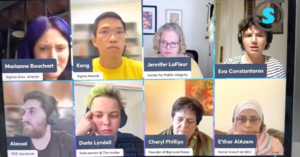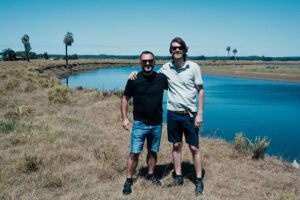For the first time in Uruguay, a team of scientists and journalists analyzed different databases on the flood line and its impact on the population and relevant infrastructure along the coast of Montevideo. The result was the research piece "The submerged city," winner of the 2023 Sigma Awards that celebrate the best data journalism in the world.
"The Submerged City" is data journalism executed with vision. The Amenaza Roboto [Roboto threat] project is a great example of journalism as a trigger for good, as the team's findings will most likely shape Uruguay's climate-related policies for years to come. It is also a data-driven effort that can inspire others around the world to tackle the same topic in the same clean and visually compelling way," said the Sigma Awards jury during the announcement of the decision in March.
The idea for doing this research came from Miguel Ángel Dobrich, journalist and director of Amenaza Roboto; and Gabriel Farías, data journalist and leader of the Special Projects Desk at Amenaza Roboto. Dobrich, who was part of the second cohort of the Oxford Climate Journalism Network of the Reuters Institute at Oxford University in 2022, took advantage of the opportunity to present "The Submerged City" project at the Open Climate Data Competition of the Uruguayan Ministry of Environment, where he obtained seed funds to make his vision a reality.
"After having intense conversations about best practices with journalists we admire, such as Surya Mattu (formerly at The Markup, Lead of CITP's Digital Witness Lab at Princeton University) and Luis Melgar (graphics reporter at The Washington Post), we put together an interdisciplinary and multicultural team — made up of members from Uruguay, Argentina and Mexico — with whom we worked on 'The Submerged City,'" Dobrich told LatAm Journalism Review (LJR).
With this research, the Roboto Threat team that was founded in 2018 as a platform devoted to technology and science journalism inaugurated its data and climate change journalism unit.

"The Submerged City is a data-driven effort that can inspire others around the world to tackle the same topic in the same clean and visually compelling way”, said the Sigma Awards jury during the announcement of the decision.
"We chose this topic because it seemed relevant to us, and journalism exists to serve the public, our communities...I am convinced that in the ‘Global South,’ small newsrooms have the opportunity to cover topics that big media cannot," Dobrich said.
The final team of "The Submerged City" was formed by Miguel Dobrich and Gabriel Farías together with scientists and technologists from different fields: Natalie Aubet, Uruguayan geoscientist and data scientist; Nahuel Lamas, Argentine specialist in geospatial images; Matilde Campodónico, Uruguayan photographer; and Antar Kuri, Mexican designer.
According to the producers, "The Submerged City" was carried out in four stages: data acquisition, development of an integrated database, creation of thematic maps, and narrative. Among the data used were those of the Uruguayan Ministry of the Environment, the National Institute of Statistics (INE, by its Spanish acronym), the Ministry of Social Development, and the Municipality of Montevideo, among others. Flood areas were extracted from the report National Plan for Adaptation to Climate Change and Coastal Zone Variability in Uruguay (2021).
"Infrastructure and demographic data were geo-referenced using ArcGIS software and data acquired from the above sources were used to develop an integrated database. The results of the analyses performed in the previous steps were visualized on thematic maps. Kernel density, raster reclassification and raster calculator tools were used for this purpose," Dobrich explained. "The thematic maps represent the intersection of the demographic and infrastructural dataset with the flood surfaces calculated for the year 2100 from the RCP 8.5 scenarios for a 500-year return period," added the journalist.

The team of 'The Submerged City' was integrated by journalists, scientists, and technologists from different fields. Photo: Courtesy.
The technical part was also blended with interviews with scientists and government agency representatives and a review of public information. The project and the complete dataset were published in an open data repository on GitHub.
The submerged city, as they explain it in the feature story itself, is a tool that shows potential damages if adaptation strategies are not developed at all levels of public administration in Uruguay. The Amenaza Roboto team believes that through their work they can influence the capacity of citizens to act and contribute to the development of better public policies.
To date, the research has had a great social and media impact both locally and internationally.
In addition to awards from the Open Climate Data Contest and the Sigma Awards, several local radio and television news programs echoed the results of the Amenaza Roboto research. Likewise, the results of the research were distributed regionally in podcast format, with a good amount of playbacks.

Miguel Dobrich and Gabriel Farías working on new research funded by the Pulitzer Center. Photo: Courtesy
According to the authors, this work also laid the groundwork for them to obtain a Pulitzer Center grant for their next project and has served as an inspiration for journalists in other countries.
"A few days ago we were informed that Visão Coop, an NGO in the poorest area of Rio de Janeiro (Brazil) that uses investigative journalism and online open data to support social development actions, was inspired by our work and as a consequence, they will work with Nicole González (Stanford) and other "favela labs" from Pará, Pernambuco and Minas to create a "national flood map," Dobrich said. "Even as a chronic optimist, I’ve been surprised by the great social and media impact our research has had….It’s the first time a team from Uruguay has won a Sigma [award] and that fills us with pride."